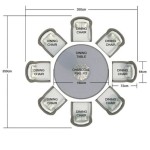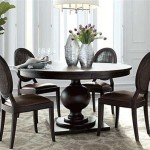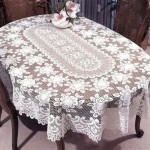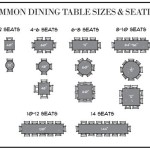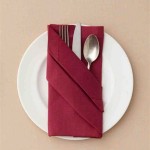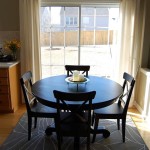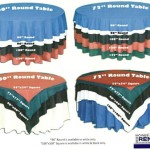How to Measure a Tablecloth for an Oval Table
Selecting the appropriate tablecloth for an oval table enhances the aesthetic of any dining area and protects the table's surface. The process involves accurate measurement to ensure the tablecloth drapes correctly, creating the desired visual impact. This article provides comprehensive guidance on measuring an oval table for a tablecloth, covering essential steps and considerations for achieving a perfect fit.
Determining Table Dimensions: Length and Width
The initial step in measuring for an oval tablecloth entails accurately determining the table's length and width. These measurements serve as the foundation for calculating the necessary tablecloth size. Employing a flexible measuring tape is crucial for obtaining precise dimensions. A rigid ruler can be employed for shorter distances, but for overall length and width, the flexibility of a measuring tape is superior.
To measure the length, extend the measuring tape along the longest part of the oval, running from one end to the other. Ensure the tape follows the curve of the table's edge for an accurate reading. Record this measurement precisely, noting the unit of measurement (inches or centimeters) for consistency.
Next, measure the width of the table. This involves measuring the widest point across the oval, perpendicular to the length measurement. Again, ensure the measuring tape follows the table's curve. Record this measurement accurately, maintaining the same unit of measurement used for the length.
Consistent and meticulous measurement practices are critical. Double-checking measurements can minimize errors and contribute to a more accurate final tablecloth size calculation. These initial measurements form the foundation for determining the ideal tablecloth dimensions based on the desired drape.
Calculating the Desired Tablecloth Drop
The tablecloth drop refers to the distance the fabric hangs down from the edge of the table. This dimension is crucial in determining the overall aesthetic and practicality of the tablecloth. The ideal drop varies based on personal preference and the intended use of the table. A standard drop typically ranges from 6 to 12 inches, but certain situations may warrant adjustments.
For casual dining, a shorter drop of 6 to 8 inches may suffice. This creates a more informal look and minimizes the risk of the tablecloth interfering with chairs or foot traffic. However, for more formal occasions, a longer drop of 10 to 12 inches is generally preferred. This provides a more elegant and sophisticated appearance.
Certain events may necessitate a floor-length tablecloth, where the fabric drapes all the way to the floor. These are often used for banquets, weddings, or other formal gatherings. In such cases, the drop measurement would be the distance from the table's edge to the floor. Take care to measure the drop from the table edge, not from the floor up to the table top to avoid measurement errors.
To calculate the total tablecloth size, the desired drop measurement must be factored into both the length and width. This involves adding twice the drop to each dimension. For example, if the table is 60 inches long and 40 inches wide, and a 10-inch drop is desired, the tablecloth should be 80 inches long (60 + 10 + 10) and 60 inches wide (40 + 10 + 10).
Consider the table's usage and formality when determining the appropriate drop. A well-chosen drop significantly enhances the overall visual appeal of the tablecloth and contributes to the desired ambiance of the dining area.
Considering Fabric Properties and Seam Placement
The type of fabric chosen for the tablecloth can influence the final fit and appearance. Different fabrics have varying weights, textures, and drape characteristics. These factors can affect how the tablecloth hangs and the overall aesthetic. Furthermore, seam placement is important, especially for larger tables, as it can impact the tablecloth's visual symmetry and structural integrity.
Heavier fabrics, such as linen or damask, tend to drape more smoothly and create a more formal appearance. Lighter fabrics, like cotton or polyester blends, can be more casual and easier to care for. When selecting a fabric, consider its resistance to wrinkles, stains, and shrinkage. Pre-washing the fabric before sewing can help minimize shrinkage issues.
For wider tables, it may be necessary to seam the fabric to achieve the desired width. When this is required, carefully plan the seam placement to ensure visual symmetry. Ideally, seams should be positioned along the length of the tablecloth, running from one end to the other. This creates a more balanced and aesthetically pleasing look.
Consider the pattern of the fabric when determining seam placement. If the fabric has a distinct pattern, align the pattern carefully across the seams to create a seamless visual effect. This requires careful planning and precise cutting and sewing.
The finishing of the tablecloth edges also plays a crucial role in the overall appearance. A well-executed hem or binding can enhance the tablecloth's durability and prevent fraying. Consider using a coordinating thread color that complements the fabric and adds a touch of elegance.
Adjustments for Uneven Table Surfaces and Additional Factors
In some cases, oval tables may have slight irregularities in their surface or shape. These variations necessitate adjustments to the measuring process to ensure the tablecloth fits properly. Addressing these discrepancies can prevent uneven draping and maintain a balanced appearance.
If the table surface is uneven, measure the drop from the lowest point to ensure adequate coverage. This prevents the tablecloth from appearing too short in certain areas. Consider adding a padded table protector underneath the tablecloth to create a more even surface and provide additional cushioning.
Some oval tables may not be perfectly symmetrical. In such cases, measure the length and width at multiple points to determine the maximum dimensions. Use these maximum measurements when calculating the tablecloth size to ensure complete coverage.
Consider the presence of any table extensions or leaves. If the table is frequently extended, measure the table with the extensions in place to determine the appropriate tablecloth size for the maximum table length. Alternatively, consider having multiple tablecloths for different table configurations.
Finally, account for any decorative elements or trim that may affect the tablecloth's overall dimensions. If the tablecloth will have a decorative border or fringe, factor this into the final measurements to ensure the desired drape is achieved. Small details such as these ensure a more professional finish.
By carefully considering all these factors and employing accurate measurement techniques, the process of selecting a tablecloth for an oval table becomes more predictable and successful. This meticulous approach ensures not only aesthetic appeal, but also practical functionality, leading to a more satisfying dining experience.

Tablecloth Size Calculator Find The Right

Oval Tablecloth Classic Modern Design Table Cloth 54 X 72 Inch Indoor Outdoor Waterproof Wrinkle Free Durable For Kitchen Dinner Restaurant Holiday Picnic Com

Tablecloth Size Calculator Oval Table Cloth Sizes

Made To Measure Linen Union Oval Tablecloth Express Tablecloths Textiles

Tablecloth Size Calculator Find The Right

Tablecloth Sizes Ilrated Charts Guide Table Cloth Dining

Tablecloth Size And How To Choose The Right One

Tablecloth Size Calculator Williams Sonoma Taste

Oval White Protector Simply Tablecloths

Use This Tablecloth Size Chart For Perfect Party Planning Lovetoknow
Related Posts

